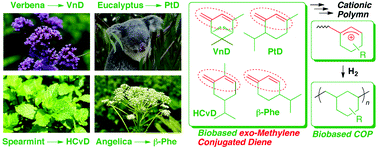Terpenoid-derived conjugated dienes with exo-methylene and a 6-membered ring: high cationic reactivity, regioselective living cationic polymerization, and random and block copolymerization with vinyl ethers†
Abstract
A series of biobased conjugated dienes with exo-methylene and a 6-membered ring was prepared from naturally abundant terpenoids bearing an α,β-unsaturated carbonyl group, such as verbenone, piperitone, or carvone, and cationically polymerized to form novel biobased cycloolefin polymers with characteristic structures originating from natural products. The obtained exo-methylene-conjugated dienes showed high cationic polymerizability comparable to that of vinyl ethers despite the absence of electron-donating heteroatoms. The polymerization proceeded via regioselective 1,4-conjugated addition by initiating systems effective for living cationic polymerization of vinyl ethers, resulting in well-defined polymers with controlled molecular weights and substituted cyclohexenyl rings in the main chain. These polymers showed high glass transition temperatures (Tg) ranging from 110 to 160 °C depending on the substituents. The hydrogenation of the main-chain cyclohexenyl ring resulted in novel biobased cycloolefin polymers with good thermal stability. The reactivity of the exo-methylene-conjugated diene monomers was evaluated by living cationic copolymerizations with a series of vinyl ethers with different reactivities, i.e., isopropyl, isobutyl, and 2-chloroethyl vinyl ether. In particular, the dienes possessing a methyl group at the 4-position, which can generate a conjugated tertiary cation, were more reactive than a representative vinyl ether with an isobutyl substituent. The sequence distribution of the copolymers varied from statistically random to tapered block structures depending on the monomer reactivities. Block copolymerizations of the dienes and vinyl ethers using the same initiating system for sequential monomer addition resulted in well-defined block copolymers bearing high (>100 °C) and low (∼0 °C) Tg segments, of which microphase separation was confirmed by atomic force microscopy of the thin film.

- This article is part of the themed collection: Sustainable Polymers


 Please wait while we load your content...
Please wait while we load your content...